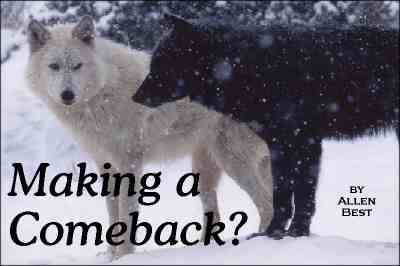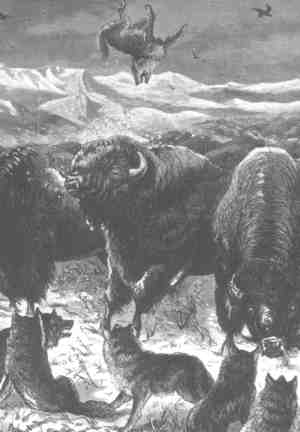Article by Allen Best
Widlife – January 2005 – Colorado Central Magazine –
HISTORIAN PATTY LIMERICK observes that if the sturdy pioneers of the West could return today, they’d find many changes interesting, if not altogether startling. There were no airplanes during the settlers’ era, for example, but many people imagined their invention. More surprising to the pioneers would be the changed attitudes, none more shocking than how we now view predators. Species that they so triumphantly eradicated are now protected and, in some cases, predators are being restocked.

Front and center in this rewilding is the wolf. Native wolves were last seen in the wild in Colorado between 1935 and 1945, depending upon which source you consult. But in recent years, wolves have been reintroduced to our north and south, and there’s currently talk of bringing the Mexican gray wolf into Colorado within the next three to five years.
The Mexican gray wolf is America’s smallest wolf and its most endangered, with only about 200 animals still alive in the world today — and most of them are in captive breeding programs. A reintroduction program was started in the late 1990s to return the Mexican gray to its native range in New Mexico and Arizona, but new locations may have to be added to save the animal.
Thus far, the Mexican Gray’s recovery has been fairly successful. But regulations agreed upon for the recovery program call for killing or removing animals that stray from designated areas, and that has presented some problems — since wolves can’t read maps. Thus, some wolves have had to be captured and rereleased. But the animals are breeding well in the wild, and their numbers are slowly increasing.
Several wolves have been illegally shot, however (and if you know who did it, the U.S. Fish and Wildlife Service is offering a $10,000 reward for information leading to the conviction of the person or persons responsible, and private organizations are offering another $35,000).
According to a December 13 news story, Tom Compton, a Colorado rancher and a member of the federal wolf recovery team, told the Denver Post, “On a scale of `angry’ from 1 to 10, I’d say Colorado ranchers are at 8 or 9. In New Mexico, they’re at 11.”
And that may explain why there’s talk of introducing wolves in Colorado. But there are many reasons to consider our backyard. For example, the White Sands Wolf Recovery area in New Mexico is thought to be good for at least 20 wolves. Whereas it’s estimated that Colorado could support from 1,000 to 1,200 wolves. So it’s not surprising that wolf fanciers keep looking toward Colorado.
Currently there’s talk about releasing the Mexican gray in the four corners region or along the Colorado/New Mexico border, and there’s also talk about reintroducing wolves, of unspecified variety, near Aspen and further north. But no formal plan has been released as yet, so reports about possible reintroduction are still highly speculative.
WITH WOLVES to the north of us and wolves to the south of us, however, they could show up whether we import them or not. In fact, the repopulation of Yellowstone National Park begun in the mid-1990s has succeeded so well that wolves have been trotting southward. And because the wolf is protected by the Endangered Species Act, federal officials have told both Colorado and Utah to begin planning to accommodate wolves. In devising rules for the animals, the federal authorities have designated Interstate 70 as the dividing line: Wolves north of the highway are threatened; wolves south of the highway are endangered.
What followed next sounds like a made-for-TV movie script. Meetings were held across Colorado, including one during March of this year, which I attended. The hotel meeting room near Denver was insufferably crowded with nearly 400 people. Several salt-of-the-earth ranchers stood up and warned dourly of the perils of wolves, but they were far outnumbered by city and suburban types. About three-quarters of the participants were 40-something women who declared their fidelity to the return of wolves, and that distribution seems common to the wolf issue. Yet for all the passion, the discussion sounded academic – like theologians arguing about how many angels can dance on the head of a pin.
But in June, the wolf story became real. A female wolf that had been in Yellowstone only a few months before was smacked by a vehicle on I-70 west of Idaho Springs. The body came to rest slumped against a guard rail on the highway median. A few feet more, and the wolf would have been on the literal legal divide between a threatened species and an endangered one. As it was, this particular wolf was in much worse shape – dead.
But a dead wolf has value that a live one does not. Under Colorado’s procedure for evaluating sightings of endangered animals, even the best paw prints and well-collected scat add up to no more than a “probable.” A congealing body within a 35-minute drive of downtown Denver was guaranteed front-page coverage and the 10 o’clock news in Denver and hence Colorado media. This was a smoking gun! Wolves were back!
At one time, wolves populated most of the United States and far down into Mexico. Accounts from the frontier spoke occasionally of wolves, even if, just as lynx were confused with bobcats, wolves were sometimes confused with coyotes. In fact, wolves are three to four times heavier than coyotes, with the average male weighing in at 90 pounds.
AS IN EUROPE, wolves were seen as agents of darkness, symbols of evil. “Almost all literary, religious, and historical references to the wolf, except those found among the North American Indians, are pejorative in the extreme,” writes John A. Murray in the book, Wildlife in Peril: The Endangered Mammals of Colorado. “This bias against the wolf, however goes even deeper than literature. It is inextricably intertwined in the very roots of language, both in the definition of the wolf and its etymology.”
Consider that a fox, another predator, is also a metaphorical name for a cunning person or even a good-looking young person. A wolf, however, is a greedy or cruel person, or a sexually aggressive or predatory man.
THE WOLF’S larger trouble in the West, however, came first as a result of the near eradication of ungulates. Bison were probably the most common of the ungulates, and wolves trailed the vast herds that once cloaked the Great Plains and mountain valleys. As the bison disappeared, so did the wolves. Other grazing animals also disappeared; populations of elk and deer plummeted in the first decades after the miners arrived. By 1911, only 1,600 elk were believed to exist across Colorado.
The U.S. government set out to kill what wolves remained, at least ostensibly on behalf of livestock ranchers. In 1915, the U.S. Biological Survey was created with responsibility to eliminate large predators from the public lands of the West. Coyotes, mountain lions, and bears were targeted in addition to wolves. An arsenal of traps and lethal poisons were used. An array of other predator species that posed no particular threat to livestock also fell victim, among them Canada lynx, bobcats, and foxes.
Instructive of this episode of wolf eradication in Colorado is the story of a wolf given the name of Old Lefty. The wolf had evidently bothered cattle ranchers along the Colorado River north of Eagle in an area called Burns Hole. Old Lefty, said to be an alpha of its pack, had been given that name because, while escaping a leg-hold trap, it had lost its right paw. Still, the cattlemen could not catch Lefty, so they enlisted the U.S. Biological Survey.
THE AGENCY IN Denver dispatched a hunter named Bert Hegeva, who during the winter of 1921 methodically went about killing the cunning wolf. A letter dispatched by the stockmen to the Biological Survey in Denver was effusive in its praise: “It is a big relief to us to know that ‘Old Lefty’ is a thing of the past — for his track on the range meant he was back and on the job of cattle killing once again. We breathe a sigh of keen satisfaction, and fully realize the capture of ‘Old Lefty’ was truly a job for our Government men who study out these things and apply methods no ordinary amateur can touch. You are doing a great work for us stockmen – let us know when we can be of any assistance in furthering your operations on predatory animal control.”
How real was the threat of wolf predation to the livestock herds? Real enough. Books about wolves say that they will prey on everything from mice to moose. If there were few elk and deer remaining in Colorado, it’s logical the wolves would have attacked sheep and cattle. Yet oddly, newspapers of the time seem to contain few stories of wolves eating Herefords and Merinos. While the Western History Department of the Denver Public Library has thick files noting the latest pilfering from the various mines around the state, the stories of wolf predation are thin.
An educated guess is that wolves in the early days of Colorado snacked on beef and lamb, but that ranchers and their allies in government inflated the threat. That’s the argument found in a new book, Wolves: Behavior, Ecology, and Conservation, edited by L. David Mech and Luigi Boitani. “During 1890- 1930, the perception of the wolf by the U.S. public and Congress was strongly influenced by accounts of outlaw wolves that allegedly killed stock in large numbers,” say the authors. “Many of these accounts were embellished and were developed, at least in part, by members of the U.S. Biological Survey to generate and maintain funding for their programs.”
Seen in this way, the stories about Old Lefty and Old Three Toes and other stealthy wolves were part of a giant public-relations campaign by government bureaucrats and the effects linger to this day. By demonizing wolves, the agency created to fight them gained more power and prestige.
Would the story of Old Tree Toes still live if it had been Alpha 3218, instead? Wolves were the terrorists of those times.
OR MAYBE THEY WERE the terrifying tale of their times. Every baby boomer from Colorado, and most states, can recall the suspenseful story about the couple parked purposefully on some lonely road, smooching in the dark when in the back, there’s a scrape, scrape, scrape. So the guy gets out to investigate…
In Russia, as well as in Sweden and other countries, a similar story is told of newlyweds and companions traveling in a sleigh attacked by a pack of wolves. The sleigh’s occupants fight the wolves, but several are lost until finally, only the young couple remain, at which time the young man contemplates making a run for help….
Why do people gravitate toward such horror stories? Even my own mother, bless her soul, once told me of somebody in Fort Morgan (name never specified) who had somehow mistaken a cat in the microwave for a casserole dish. Oh, the messy tragedy! She had, my mother solemnly informed me, been given this sad news by Mrs. Duncan, the kindly widow on the corner.
Whatever fashioned attitudes toward wolves early in the 20th century, by mid-century nearly all of the wolves south of Canada were gone, with only a few remaining in a corner of Minnesota. Even before this eradication was complete, however, there were calls for the return of wolves – in some cases by architects of the eradication. Among the first major figures to trumpet this cause was Aldo Leopold. As a young forest ranger in Arizona, he participated in the war against wolves, reasoning that they killed deer and hence detracted from the sport of hunting. Well known is the story of Leopold’s epiphanies, first watching the fierce green light fading from the eyes of the wolf he had killed in a canyon of Arizona, then later watching as the unculled deer herds ate themselves out of house and home.
By the early 1940s, with his newly revised philosophy of conservation, Leopold proposed restoration of wolves to Yellowstone National Park. About the same time, wildlife biologists began studying wolves in Alaska and elsewhere, trying to demythologize the species. Farley Mowat’s 1963 book, Never Cry Wolf, which nearly deified the hitherto demonized animal, helped revise attitudes. Soon after, there was a sea-tide change in environmental consciousness and laws. Seminal, at least as regards wolves, was the Endangered Species Act of 1973.
WITH THE NEW ACT in place, Colorado wildlife authorities initially supported designating habitat for 20 wolves, but their position reversed and then hardened into firm opposition. In 1983, the Colorado Wildlife Commission adopted the position that Colorado wished to see neither grizzly bears nor wolves returned. Only in the late 1990s, and then in minor degrees, did this position shift. Although still strongly influenced by agricultural interests, state government grudgingly conceded new attitudes held by the dominant urban and suburban majority. Also, as was evident in the reintroduction of the Canada lynx, the state reasoned that it was best to act in any way that reduced the heavy and inflexible hand of the federal government as outlined by the Endangered Species Act.
By then, the writing was on the wall. In 1994, the U.S. Fish and Wildlife Service had completed a study that showed that habitat existed for 1,128 wolves in Colorado, with the best habitat located in the San Juans, the West Elks and the Flat Tops. Moreover, two public opinion surveys revealed strong support for the return of wolves, with support somewhat stronger in the urbanized Front Range corridor. And then, the federal government began restocking ranges to the north and south.
Beginning in 1995, wolves were reintroduced to the Yellowstone region. In 1998, Mexican wolf recovery started in the area of Arizona-New Mexico where Aldo Leopold had watched those fierce green eyes flickering so many years before.
About 800 wolves now populate Wyoming, Montana, and Idaho. All available habitat in Yellowstone is occupied. Because wolves, who are strongly territorial, will kill other wolves that invade their habitat, young wolves must spread to find unoccupied habitat – heading to where they think they will find other similarly single, unattached wolves with whom they can do wolfish things. That sends about three-quarters toward Canada, but about a quarter toward Colorado.
Ed Bangs, the Montana-based Gray Wolf Recovery Team leader for the U.S. Fish and Wildlife Service, says that if wolves don’t pick up the scent of other wolves within about 100 miles, most will turn back. The prospects for dates just look too poor. As such, he does not foresee wolves repopulating Colorado on their own any time soon.
“These lone wolves could show up for decades before a male and female show up that like each other and breed and have pups,” he says. “We have had lone wolves even in Kansas and Missouri, as well as Utah, Oregon, and Washington. But there’s a big difference in talking about when we think a pack will show up in Colorado. It could be decades – or it could be next year. You never know, but I’m betting on the longer time frame.”
MEANWHILE, to the south in Arizona and New Mexico, there are only 55 wolves. The packs there have been slow to get established. Moreover, it is federal policy that when those wolves wander into Colorado or Utah, they are returned. Reports have it that one may have shown up near Durango. But since wolves look much like dogs, and some people have hybrid wolves, it takes more than sightings to establish whether endangered wolves have arrived.
Wolves might soon show up, though, and therefore the federal government has prodded state authorities to prepare a plan. The feds said that I-70 would serve as a dividing line, partly because it’s convenient but also because it serves as a very real barrier – the Berlin Wall to Wildlife, as some biologists have called it. South of I-70, wolves will receive the greater protection accorded by the Endangered Species Act, endangered. Those north of I-70 are to get the more restrained protection, threatened. The presumption holds that the wolf has sufficiently recovered north of I-70 so that the federal government can delist the species. But the feds will only do that if they can get Wyoming to back away from its insistence on regulations that would allow broad hunting of wolves.
To further complicate the issue, various wildlife restoration groups led by Defenders of Wildlife are suing the Fish and Wildlife Service to prevent this delisting. They argue that the gray wolf has been restored to only a small portion of its former range, probably less than 5 percent of their historic range in the continental United States. The Endangered Species Act specifies restoration to a “significant” portion of their former range. The wolf, they say, is being prematurely delisted because of its controversial status.
While these arguments get played out, Colorado has begun work on the ground rules for treatment of wolves if and when the animal is delisted. Specifically at stake is how wolves will get treated north of I-70. Those south of I-70 will remain protected, no matter what. But, the arguments will probably set up compromises that will be applied across Colorado in a later day.
The forum for working out these compromises is a state task force composed of ranchers, environmentalists, sportsmen and biologists which was appointed earlier this year. Despite reports of some head-butting, the task force got to first base without coming to blows.
The ground seems to have shifted more significantly for livestock growers. “As strongly as we don’t want wolves in this state, we have to acknowledge that times have changed, and there are a lot of people who do want wolves,” says Bonnie Kline, executive director of the Colorado Woolgrowers Association. But livestock producers don’t like wolves any more than before, she says. To them wolves are a “really bad deal.”

THE AGREEMENT so far is limited. It could be more restrictive than what the federal government specifies, but no less restrictive. There is to be stepped-up monitoring of big-game populations to gauge the impact of wolves. Ranchers are to be compensated 100 percent for confirmed wolf kills and 50 percent for probable. If a wolf is caught killing livestock, it can be killed. But ranchers had wanted the authority to kill wolves that they think will kill livestock later.
Biologists, however, do not expect livestock predation to be a large issue. “Confirmed livestock predation has been about half of what we thought it would be, and we had thought it would be low,” says Bangs, of the Yellowstone releases. “Each year we kill about 6 percent of the wolf population, because of problems with livestock.”
Still ahead is the thornier issue of whether wolves will be reintroduced to Colorado. The Fish and Wildlife Service is considering that possibility, but has not yet devised a plan. Meanwhile, various groups, including Boulder-based Sinapu, are lobbying for reintroduction. “We believe that an earnest discussion about restoring wolves to Colorado and the Southern Rockies needs to take place sooner, rather than later,” says Rob Edwards, the group’s carnivore restoration program director.
Why is restoring wolves important? “Just as the suppression of fire from Western landscapes has broad and often catastrophic implications, wolves are unbelievably important to the health and diversity of wild America, and we cannot afford to delay the process of weaving them back into the landscape,” Edwards says.
Wildlife biologists have cautioned about reading too many benefits into wolf reintroduction. “I am wary of looking at the world through wolf-tinted glasses,” says Ed Bangs, team leader for the Fish and Wildlife Service. “Just as wolf opponents jump to hang blame for everything on wolves, wolf proponents have a tendency to find unblemished good in wolves. To them, everything from the family network of wolves to their control of coyotes is cited. What this says, he argues, really speaks more to human values than anything having to do with wolves.”
What can be said for sure about the impact of wolves to the Yellowstone region? “The coyote density may be down slightly, or maybe not,” says Bangs. “We know that willow and also aspen are growing in places where they haven’t grown in years. The reason for that is not fewer elk, but rather that elk that are hunted by wolves act more like wild animals. They are spending more time in the timber. They are spooked more easily. And they don’t hang around the streambeds like domestic livestock. The result is that willows and aspen are now growing in Yellowstone in places where they haven’t grown in 70 years.”
This, in turn, gives more material for beavers to work with, which slows runoff of rain and snowmelt. Beyond that, it’s hard to judge the impact of wolves, says Bangs, because there are so many other changes constantly occurring on the landscape – weather, new roads, and on and on.
IF AND WHEN WOLVES return to Colorado, he says, don’t expect much impact. They will not stay in designated wilderness areas, because most designated wilderness is located at high elevations, with a preponderance of rock and ice. Wolves want to be around prey, which means at lower elevations. Even so, he does not expect major effects to big game herds because Colorado’s wildlife habitat is just too fragmented.
How about the predation we most often think about when hiking alone? There are reliable reports even today of children being killed by wolves in India, and reports of the past clearly indicate wolf predation on people in Russia and Scandinavia. But Bangs points out that there has been no verified instances of wolves killing people in North America. Biting? Yes, but not killing. In contrast, he points out, deer kill about 20 people a year with their hooves or by goring.
“There are 25 million Canadians living with 60,000 wolves,” he adds. “Maybe the Canadians just taste bad, I don’t know. But nobody who lives around wolves is afraid of wolves.”
Not so in Colorado where wolves are just a possibility. In 1996, I was covering a blow-up about wolves at Eagle. Attending the meeting was Edwards, the Sinapu representative. Although by then he was living in Boulder, Edwards had grown up in semi-rural Idaho and, he says, herded sheep on the Navajo Nation. “I can put a saddle on and ride a horse without any instruction,” he says. “I am very comfortable with rural attitudes.”
At meeting’s end, Edwards and a rancher from the Burns Hole country, which Old Lefty had once reportedly terrorized, went nose to nose. “I can’t believe that you would want to bring back wolves when my grandfather worked so hard to get rid of them,” said the rancher.
I talked to the rancher later, and he told me about the time when his grandparents had taken a sleigh from town to their ranch, and a hungry pack of wolves had trailed close behind the whole way. Nothing had come of it, but the rancher was sure that something could have.
At the time, I didn’t know enough to ask if his grandparents had been newlyweds.
Allen Best keeps the wolf away from his door (usually) with free-lance writing from Eagle and Arvada.



